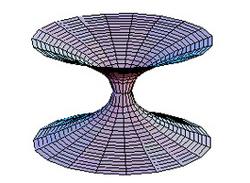| |
| |
 Ronnie Chen/Hampton University,
from aThinkQuest
project.
Ronnie Chen/Hampton University,
from aThinkQuest
project. |
|
Science fiction? A
wormhole can connect two parts of our universe
or two different universes with a spacetime
bridge. |
|
|
|
|
Spaceships on Star Trek: Deep Space 9 regularly take a shortcut
between distant parts of the Universe by traveling through a
wormhole, a kind of spacetime tunnel. Although Einstein's General
Relativity theory allows wormholes to exist, physicists have been
trying for decades to construct them mathematically without
breaking any other laws of physics. Most researchers agree that
wormholes require "exotic matter"--stuff that is repelled by
gravity, rather than attracted--but some have claimed ways around
that problem. Now a report in the 27 July PRL
shows that all wormholes, no matter how cleverly constructed,
require exotic matter--a condition that many in the field are
already working to satisfy.
According to Matt Visser of Washington University in St. Louis,
"The good news about Lorentzian wormholes is that after about ten
years of hard work we cannot prove that they don't exist." But a
publication five years ago (Phys.
Rev. Lett. 71, 1486) showed that a large class of
wormholes require exotic matter to keep them open. Researchers
haven't given up, however, because exotic matter--which has less
energy than a pure vacuum--does exist, at least in small amounts,
thanks to the ghostly virtual particles in certain quantum physics
experiments.
On the other hand, no one knows if enough of this weird stuff
can exist in one place at one time to create a decent-sized
wormhole. To avoid the problem, a number of theorists have claimed
to construct special wormholes that do not require exotic matter.
In their PRL paper, Visser and David Hochberg, of the
Laboratory for Space Astrophysics and Fundamental Physics in
Madrid, Spain, show that all wormholes--even time-dependent and
asymmetric ones--require exotic matter, which in turn requires
quantum mechanical effects. "You cannot just get away with normal
classical physics," says Visser. The authors blame many of the
contrary claims on confusion about the precise definition of a
wormhole and the concept of "passing through" it.
Their approach was to rigorously define a wormhole "throat" (the
narrowest point) and show that because light rays spread out as
they emerge from it, there must be a kind of "antigravity"--the
hallmark of exotic matter. In the process they found that time-dependent
wormholes actually have two throats, one for each direction
of traffic, and they say that was one source of the confusion: A
theoretical traveler could paradoxically pass the middle of the
wormhole without actually reaching the throat for her direction.
Part of the problem is the lack of a good physical picture for a
dynamic wormhole, which is a complicated four-dimensional object;
the usual image (see figure) is legitmate only for one that
doesn't change in time.
The requirement of exotic matter has been "pretty well
understood in the community," says Eanna Flanagan, of Cornell
University, despite the number of contrary papers and the lack of
an air-tight proof. But the new work does a good job of showing
that requirement in a new and interesting way that supplements
previous work, while also clarifying errors in other research, he
says.
Null Energy Condition in Dynamic Wormholes
David Hochberg and Matt Visser
Phys.
Rev. Lett. 81, 746
(print issue of 27 July 1998)
|
|
|